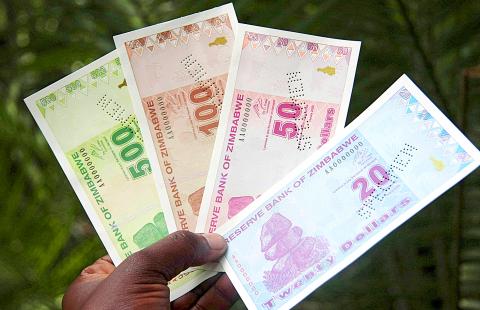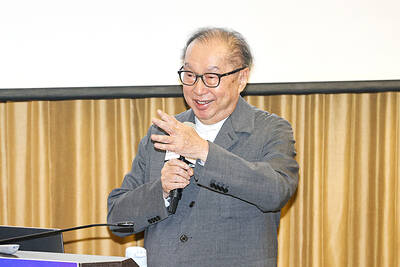Zimbabweans know the risks of worthless money all too well after hyperinflation from 2007 to 2009 gave them the 100 trillion Zimbabwean dollar banknote that barely bought a loaf of bread.
Now they fear that the government is about to create another devastating crisis by printing its own “bond notes” that will officially be worth the same as the US dollar.
Many Zimbabweans who lost all their savings in the hyperinflation years dread Zimbabwean President Robert Mugabe’s government issuing so-called “surrogate money,” set for next month.

Photo: AFP
“My fear is that we will have a repeat of 2009,” said Petros Chirenje, 43, an electrician based in Harare. “I had 17 trillion Zimbabwean dollars in my bank account and I lost everything when the government switched to foreign currency. I worry that the US dollars in my account will be converted to bond notes.”
The country has used the US dollar since 2009 after issuing so many Zimbabwean dollars that hyperinflation peaked at 500 billion percent and the national currency was abandoned.
However, a shortage of US banknotes has added to Zimbabwe’s accumulating economic woes.
Banks are scarcely able to dispense cash, the few remaining businesses are grinding to a halt, and the government repeatedly fails to pay soldiers and civil servants on time.
Chirenje buys imported electrical supplies because few goods are made in Zimbabwe — but bond notes are unlikely to have much value to international producers.
“The government says the bond notes will be equivalent to the US dollar, but my question is ‘how?’” Chirenje said.
The new notes, starting with small denominations of US$2 and US$5, were meant to be introduced this month, and are now due out next month, but no confirmed date has yet been announced.
In response, Zimbabweans have been lining up outside banks to try to get hold of the few remaining US dollars. Withdrawals are sometimes limited to just US$50 per person a day.
Mavis Chapo, a housewife, said she was withdrawing all her money “before it is eaten up.”
“I would rather take my money out and buy things I did not plan to buy,” 54-year-old Chapo said outside the Central African Building Society in Harare, adding that she would not give up despite waiting for five hours in the hot summer sun.
“I cried when I lost all the money in my account in 2009 and was later told it was worth only US$5. I am wiser after that experience. I don’t want to cry again,” she said.
The state-run Herald newspaper last week said that “the introduction of bond notes early next month is on course, with massive educational campaigns expected to start on October 31.”
Zimbabwean Reserve Bank Governor John Mangudya on Thursday sought to allay fears that authorities were using bond notes to covertly re-introduce the Zimbabwean dollar.
“These are just short-term measures,” he told a meeting of local business executives in Harare. “The long-term measures are to ensure that the economy is investor friendly.”
He said bond notes would be introduced gradually, and claimed they would help boost exports and production as well as the cash crunch.
Such reassurances are unlikely to persuade investors who have pulled out of Zimbabwe due to the authoritarian regime of 92-year-old Mugabe, laws forcing foreign-owned companies to sell majority stakes to locals, and endemic corruption.
At least 4,600 companies have closed down in the past three years, according to central bank data cited by Bloomberg News.
“The bond notes are not a solution to the liquidity crisis,” said Obert Gutu, spokesman for the main opposition Movement for Democratic Change party. “This is a dead end and the talk of bond notes is causing anxiety and panic as shown by the numbers of people going to make withdrawals.”
The bond notes plan, which was announced in May, hit a further snag last week with reports that the German company that was to print the new currency had pulled out of the deal.
“No one can trust the government,” University of Zimbabwe economics professor Tony Hawkins said. “It seems the left hand does not know what the right hand is doing and this is not good for the economy.”
A wave of protests this year has shaken Mugabe’s 36-year rule, with “no to bond notes” among the slogans at anti-government demonstrations that have been regularly crushed by police.
The government said the new notes would be backed by a US$200 million support facility provided by the Cairo-based Africa Export-Import Bank.

BYPASSING CHINA TARIFFS: In the first five months of this year, Foxconn sent US$4.4bn of iPhones to the US from India, compared with US$3.7bn in the whole of last year Nearly all the iPhones exported by Foxconn Technology Group (富士康科技集團) from India went to the US between March and last month, customs data showed, far above last year’s average of 50 percent and a clear sign of Apple Inc’s efforts to bypass high US tariffs imposed on China. The numbers, being reported by Reuters for the first time, show that Apple has realigned its India exports to almost exclusively serve the US market, when previously the devices were more widely distributed to nations including the Netherlands and the Czech Republic. During March to last month, Foxconn, known as Hon Hai Precision Industry

Taiwan Semiconductor Manufacturing Co (TSMC, 台積電) and the University of Tokyo (UTokyo) yesterday announced the launch of the TSMC-UTokyo Lab to promote advanced semiconductor research, education and talent development. The lab is TSMC’s first laboratory collaboration with a university outside Taiwan, the company said in a statement. The lab would leverage “the extensive knowledge, experience, and creativity” of both institutions, the company said. It is located in the Asano Section of UTokyo’s Hongo, Tokyo, campus and would be managed by UTokyo faculty, guided by directors from UTokyo and TSMC, the company said. TSMC began working with UTokyo in 2019, resulting in 21 research projects,

Ashton Hall’s morning routine involves dunking his head in iced Saratoga Spring Water. For the company that sells the bottled water — Hall’s brand of choice for drinking, brushing his teeth and submerging himself — that is fantastic news. “We’re so thankful to this incredible fitness influencer called Ashton Hall,” Saratoga owner Primo Brands Corp’s CEO Robbert Rietbroek said on an earnings call after Hall’s morning routine video went viral. “He really helped put our brand on the map.” Primo Brands, which was not affiliated with Hall when he made his video, is among the increasing number of companies benefiting from influencer

Quanta Computer Inc (廣達) chairman Barry Lam (林百里) yesterday expressed a downbeat view about the prospects of humanoid robots, given high manufacturing costs and a lack of target customers. Despite rising demand and high expectations for humanoid robots, high research-and-development costs and uncertain profitability remain major concerns, Lam told reporters following the company’s annual shareholders’ meeting in Taoyuan. “Since it seems a bit unworthy to use such high-cost robots to do household chores, I believe robots designed for specific purposes would be more valuable and present a better business opportunity,” Lam said Instead of investing in humanoid robots, Quanta has opted to invest